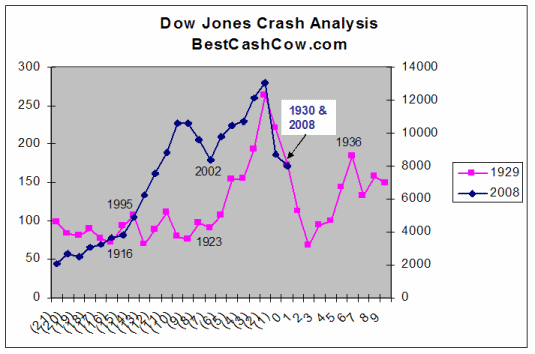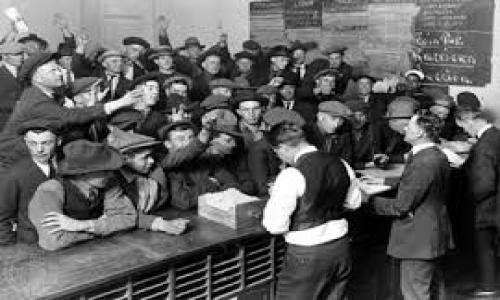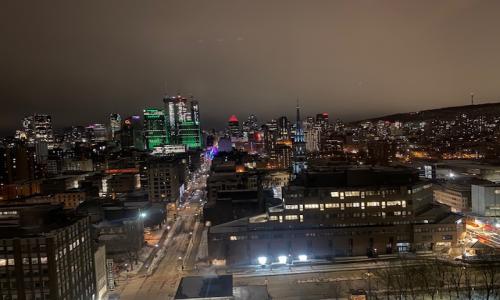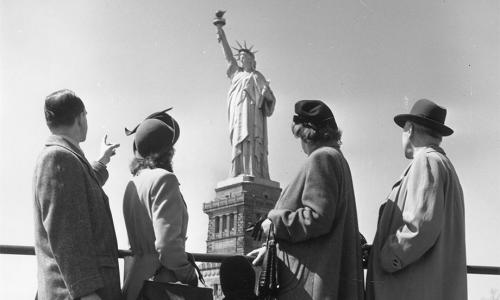Today, as I watched the Dow sink below 8,000, I wondered how the sell-off of the last six months compares to the sell-off during the Great Depression. The chart below shows what I found. To create it, I graphed historical data taken from the DJ Indexes website for the Dow Jones Industrial Average.

Let me explain how to read the chart.
The years 1930 and 2008 are time 0 on the x axis of the graph. I then looked at the 21 years before 1930 and 2008 to see how the markets performed before the 1930 and 2008 crashes. I also charted the 10 years after the crash in 1930, represented by the positive numbers on the X axis. The left Y axis shows the Dow's price during the early part of the 20th century and the right Y axis shows the Dow's price in more modern times. One other note on the methodology is that I used the closing price of the Dow on November 11 of each year.
As you can see by looking at the blue and pink lines, before both crashes there was a sharp run-up in the value of the Dow. But the data shows that the pre-crash bubble is much bigger now than it was prior to the Great Depression. While the Dow increased about 2.5x during the priod 21 years before the crash of 1929-1930, it increased over 6X from 1988 to 2008.
In 1929, with Black Friday, the Dow began to deflate and it hit a bottom in 1932. By that point, the Dow was down almost 75% from its peak a few years earlier. Today, the Dow has fallen about 42% from its high of 13,850. As the chart shows, if this economic downturn is not over and comes close to approaching the early severity of the Great Depression, then the Dow is not done falling. It's important to note that the largest damange to the market happened at the beginning of the Depression. While economic problems continue until the beginning of World War II, the stock market began to recover from its lows in 1936. What does that mean? It means that even if our current downturn doesn't last as long as the Depression, it could be as deep for a concentrated period of time, and during that time cause further equity losses.
I don't usually use Wikipedia as a source but I came across this entry on the Great Depression and thought it appropriate. You can decide if there are parallels to today:
The Great Depression was not a sudden total collapse. The stock market turned upward in early 1930, returning to early 1929 levels by April, though still almost 30 percent below the peak of September 1929.[6] Together, government and business actually spent more in the first half of 1930 than in the corresponding period of the previous year. But consumers, many of whom had suffered severe losses in the stock market the previous year, cut back their expenditures by ten percent, and a severe drought ravaged the agricultural heartland of the USA beginning in the northern summer of 1930.
In early 1930, credit was ample and available at low rates, but people were reluctant to add new debt by borrowing. By May 1930, auto sales had declined to below the levels of 1928. Prices in general began to decline, but wages held steady in 1930, then began to drop in 1931. Conditions were worst in farming areas, where commodity prices plunged, and in mining and logging areas, where unemployment was high and there were few other jobs. The decline in the American economy was the factor that pulled down most other countries at first, then internal weaknesses or strengths in each country made conditions worse or better. Frantic attempts to shore up the economies of individual nations through protectionist policies, such as the 1930 U.S. Smoot-Hawley Tariff Act and retaliatory tariffs in other countries, exacerbated the collapse in global trade. By late in 1930, a steady decline set in which reached bottom by March 1933.
The quote doesn't touch on the obvious parallels in the banking system. Although there haven't been as many bank failures, the magnitude of the financial failures today are enormous - Bear, Lehman, Fannie, Freddie, Wachovia, Washington Mutual, Countrywide, National Citi, AIG. I realize not all of these were failures but many of the banks listed were purchased at firesale prices to prevent a failure.
The question to ask yourself about this recession is whether you think it's like the relatively mild downturns of 2001-2002, and 1991-1992 and even 1980 or is it really the worst economic downturn since the Great Depression? Because if you believe the latter, then that blue line has further to fall.
For an update on this article from August 3, 2011, click here.














Comments
Confused
March 06, 2009
To Econometrics today I read the us farmers are not planting corn because the price per bushel is way below the cost of growing it,there goes the food Cheers
Is this review helpful? Yes:0 / No: 0
Louay S
March 07, 2009
One major difference that drive the economy more than supply and demand is productivity, and since the use of personal computer (1989) and Internet (1995) Productivity went up by far more than the creation of agriculture tools or even electricity, so we can't compare 1929 heap of bubble by a true growth of 199x and early 200x. That is part of the 6X compare to 2.5X.
Let me ask any one this: without a PC and Internet, how match less your productivity will go down?
Is this review helpful? Yes:0 / No: 0
Adenovir
March 08, 2009
Excellent chart...I put a link up on the Motley Fool:
http://boards.fool.com/Message.asp?mid=27504094
It really depends on where you call the start of bull market. The pre-1929 run-up is clearly steeper but our current run-up is larger in magnitude. At this point we are further down than 1930. It may in fact be a race to the bottom.
Thanks!
Is this review helpful? Yes:0 / No: 0
Jerrold Peterson
March 10, 2009
The Stock Market bubble and crash of 1929 and 2008-09 have the same general cause: mal-distribution of national income. From 1910-1930 monopolies in most of the major industries redistributed income away from labor to capital. This non-market redistribution of income left labor unable to demand the products that industry was producing. From 1980-2008 the deregulation of the economy allowed the capitalist class to again redistribute income away from labor to capitalists. This redistribution, again, left labor unable to buy the houses and autos among other things that industry is producing. Louay S is in general right.
Chamois an old economist
Is this review helpful? Yes:0 / No: 0
nope
March 11, 2009
Valuations were not as inflated in 2007 as they were in 1929. The fall has been just a precipitous, but the absolute decline just won't be as severe. We may have already hit the bottom actually.
Is this review helpful? Yes:0 / No: 0
Bazza
March 12, 2009
Nice analysis. An alternative and maybe surer base might be the longer term level of the index without the bubble. From your charts, the 1929 level might be about 130 and the Dow fell to say 70. The present base level might be about 10000 so an equivalent fall would take us to about 5400, which is about where Jacob Fries thinks it will be at the end of 2009. Still not pretty.
Is this review helpful? Yes:0 / No: 0
Sarah South Jersey
May 06, 2009
apologize for non economist comment:
due to mind boggling incomparable difference in information sharing globaly and corresponding awareness of global economic impact & hardship -- seems the powers are going to squeeze the best and the brightest to stop the hemorrage and it shouldn't collapse as badly as in the OLDEN DAYS (1929)
now the whole fungus mushroom of exploding population WANT to survive and enjoy life and not participate in apocolyptic wallowing in reality show misery
which leads me to believe the captains will right the ship
as Nope suggests, we may be sailing again now, albeit with a sputtering engine.
Is this review helpful? Yes:0 / No: 0
Alex
May 13, 2009
i think the stock market is close to crashing again and we will soon have another great depression
Is this review helpful? Yes:0 / No: 0
StupidOne
May 13, 2009
Alex, I agree with you (we are in for some tough times, I don't think a depression though). I think the market was fluctuating a bit trying to make sense of things. With the bankruptcy of Chrysler and the pending bankruptcy of GM, I think we are in for some tough times. Look at the store closings in the retail sector, retailers are closing more stores than they had planned to. Yes, the layoffs went down quite a bit but I think some companies are currently in the planning stage to see what is the next step. I think if things continue as is, the layoff numbers will go back up.
Is this review helpful? Yes:0 / No: 0
raderator
May 31, 2009
The US economy was destined to collapse anyway because of the aging of the boomers and the transition of the US population to 3rd world makeup. The Great Depression happened to a much younger and much whiter country. The cause was the same, Marxist opportunists. Some of Obama's handlers are probably the grandchildren of the very Marxists who heaved Molotov cocktails in Russia and instituted their plans in FDR's whitehouse.
"There is nothing wrong with Communism. Some of my best friends are Communists." -FDR. Obama can make the same claim.
Is this review helpful? Yes:0 / No: 0
Add your Comment
use your Google account
or use your BestCashCow account